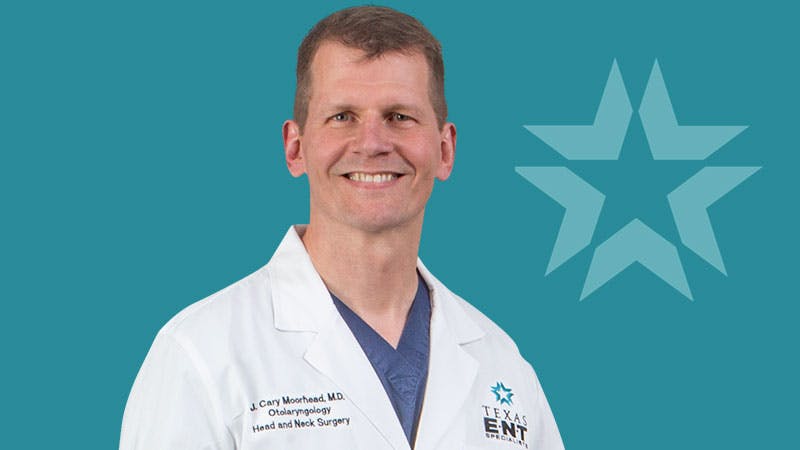
If you have symptoms of sleep apnea, your doctor may recommend a polysomnogram (a sleep study). Did you know you can complete the test in the comfort of your own home? Read on to learn more about sleep apnea testing and the treatment options available today.
Shelby Stockton: (00:00)
Welcome to the Texas ENT audio blog. I'm your host, Shelby Stockton, and today I talked with otolaryngologist, Dr. Cary Moorhead. Medical testing can be scary, so Dr. Moorhead walks us through a sleep apnea test. You'll be shocked at how simple it is these days. He also discusses treatments for sleep apnea, specifically a new device called Inspire. If you have sleeping issues, this one's for you.
Dr. Moorhead, thanks for spending some time with me today.
Dr. Cary Moorhead (00:28):
Oh, my pleasure. Thank you.
Shelby Stockton (00:30):
So today we're discussing sleep apnea, but specifically, sleep apnea testing. And any kind of medical testing's nerve-wracking for most of us, but knowing what's ahead helps minimize fears. Dr. Moorhead, could you walk us through a typical sleep apnea test?
Dr. Cary Moorhead (00:47):
Well, Shelby, you're exactly right. A lot of our patients are nervous about the idea of getting a sleep test done. Some of them even are holding off on appointments because they're worried I'm going to get them involved in something that's complicated or uncomfortable.
So first of all, there are different types of sleep studies, and if we broke them down into real general categories, one would be what we call an in-lab study, and the other would be a home study. So in-lab studies are... they were what everyone used to do to evaluate sleep and sleep apnea. It involved going into a lab, spending a night with a technician, and usually getting hooked up to about 19 different wires, sleeping in a strange bed. And a lot of patients who had studies in the past, that's what they remember. Or if they have a family member who had a sleep study, that's what they're anticipating we need to do.
Most of the time now, I'd say at least 90% of the time, we're doing these studies as home studies. And so, what that means is that you're actually going to get it done in your own bed. And we use a variety of different devices to do it, but it's simple, it's comfortable, it's something that you do at home. And then you have the sleep study interpreted after that.
In our practice now, the technology has come along so far that a patient can come in, tell us about their sleep problem, and we can hand them a device that they take home, that they wear. It's as easy as putting it on their finger and their wrist, and it does a sleep study just like that. And these devices now are connected to your smartphone. So in the morning when you wake up, you download it to a little app, the information goes to the cloud, and then we get a report that we can interpret, have you come back a week later, and then the whole thing is wrapped up really in no time.
So a sleep study now has become a very simple process, something that patients really shouldn't have any anxiety towards undergoing. If we need to, we always can do a study in the lab if we need some additional information, but that's a pretty small percentage of patients these days.
Shelby Stockton (03:24):
Are these devices comfortable to sleep in?
Dr. Cary Moorhead (03:29):
The sleep study, like I said, most of them now will attach to your finger and your wrist. I'd say about one out of every 10 patients feels that the little thing on their finger is tight and sometimes they have to shift it to a different finger or something like that. But that's really about the only complaint.
Shelby Stockton (03:48):
Okay, fair enough. So I know a lot of people know if they're diagnosed with sleep apnea, they have to deal with this thing called a CPAP machine, which can be... It can be a lot. Is that the only treatment?
Dr. Cary Moorhead (04:02):
So usually, when people are diagnosed with sleep apnea, we do encourage them to try CPAP because statistically, that has been the most effective answer. The biggest problem with CPAP is there's a large percentage of patients who just can't comply with it for one reason or another. And if we look at studies between 40% and 50% of patients never really are able to get CPAP to work for them.
So the big excitement these days is really around the Inspire implant as the big alternative to CPAP for people that are unable to tolerate CPAP. And for anyone who doesn't know, Inspire is an implant similar to a pacemaker that's placed under the skin and the chest. It has a lead that comes up and attaches to a nerve on the tongue and at night, instead of putting on a CPAP mask, you turn on this device with a little remote control. And then once you fall asleep, whenever you take a breath, the muscles of the throat are stimulated to open instead of being allowed to collapse the way they do during sleep apnea. And that is turning out to be statistically our most effective alternative to CPAP for those types of patients.
Shelby Stockton (05:30):
That's amazing. Now, does that device, is that during the day? Do patients feel it or is it...
Dr. Cary Moorhead (05:35):
No, during the day, it would... When they wake up in the morning, they turn it off with the remote, so they don't feel anything. So one thing I would want to point out, just so everybody knows, to get Inspire, there are pretty specific qualifications. People have to have a BMI or body mass index usually below 35 or 32.
So if you're too overweight, it's not really an option. And it's approved for people that have moderate to severe sleep apnea. So someone who has sleep apnea that's too mild also would really not be qualified to get it. But moderate to severe sleep apnea in a patient who's not able to comply with CPAP, who has a BMI of under 35 or 32, depending on the insurance, would be considered a good candidate.
Shelby Stockton (06:34):
Fantastic. What would you say to a potential patient who's nervous about all of this?
Dr. Cary Moorhead (06:40):
Well, it doesn't hurt to get evaluated. So just because you didn't go in to have it checked out doesn't mean you don't have the problem. So if you think that you have a snoring problem and you wonder if you have sleep apnea, the easiest thing is to go in, at least get it evaluated and try to find out how serious this might be and what the options might look like because they may not be as bad as you think they are.
Shelby Stockton (07:13):
Great. Well, Dr. Moorhead, thanks for your time. We really appreciate it.
Dr. Cary Moorhead (07:17):
Yeah, well, thank you so much.

